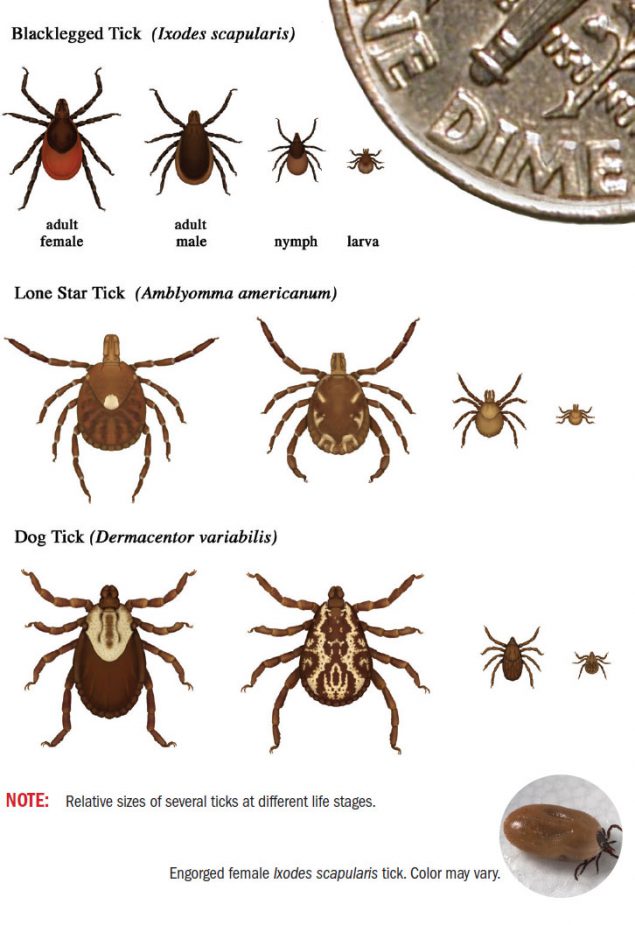Why Do Ticks Turn White After Feeding
Tick-borne diseases like Lyme disease, anaplasmosis, and babesiosis are a serious health concern in New Hampshire. Although ticks are likely to be active any time the temperature is above freezing, you are more likely to contract a tick-borne illness in the summer months.
"While there are several tick-borne illnesses to watch out for in our area, they are carried by the smaller Deer [or Black Legged] Ticks, not Dog Ticks." Says Marika Henegan, MD, a provider at Cheshire's Urgent Primary Care Visits (Urgent Visits). "A baby, or nymph, Deer Tick can be hard to notice, which is why checking yourself thoroughly for ticks is important after you have been in the woods or long grass."
Tick identification
At first glance, a nymph may just look like a small brown or black spot that is hard to remove, but all ticks have 8 legs, even if you need a magnifying glass or your phone's camera zoom function to see them.
As pictured below, Deer Ticks are small with dark heads and legs and bodies that vary in color depending on their sex and how much they have fed. Dog Ticks are lighter brown and easier to see due to their size. The Centers for Disease Control (CDC) reports that Lone Star Ticks, pictured here, are generally only found in the South East U.S. and rarely north of Massachusetts.
The CDC notes that unengorged (unfed) Deer Ticks are typically flat. If the tick has a swollen or rounded body, and the color has changed from brick red to a gray or brown, is an indication that the tick has been feeding and may have been attached for more than 36 hours.

What should I do if I find a tick on me?
"Don't panic. If it is not attached you have nothing to worry about. If you are sure the Deer Tick has been attached for less than 36 hours, no further action is required (beyond removing the tick and cleaning the bite area) and this does not require a visit to a healthcare provider," says Dr. Henegan.
"If you aren't sure how long it has been attached or know that it could have been more than 36 hours, seek medical attention that day or the next. Medication to help prevent Lyme disease can be given up to 72 hours after removing the tick."
"If you have removed the tick at home, place it in alcohol or a Ziploc baggie and bring it with you. We are experienced at identifying ticks and this can help determine your recommended course of treatment," Dr. Henegan suggests. "And remember you don't need to make an appointment to visit our Walk-In Care Clinic in Keene. We're here for you 365 days a year."
How do I safely remove an attached tick?
Once a tick bites you, it will likely attach itself to you and won't let go until it is full. Depending on the type of tick, this may take 3-10 days. The CDC recommendations are:
- Do not try to remove an attached tick with your fingers. Squeezing its body rather than its head puts you at greater risk of contracting tick-borne illnesses.
- Remove the tick immediately by grasping the head with fine-nosed tweezers as close to the skin as possible. Do not twist the tick. Instead, use a slow, steady, upward motion to pull the tick off. This minimizes the chances you will squeeze the body or leave the head behind.
- Clean the bite area with alcohol or disinfecting soap and water, then treat with a topical antibiotic.
Possible symptoms of tick-borne illness
The most common symptoms of tick-related illnesses are:
- Fever/chills
- Aches and pains in muscles or joints
- Fatigue
- Rash (appearance can vary by disease), typically a circular non-itchy or painful rash at the site of the bite, but it can be elsewhere.
Other symptoms to look for:
- Severe headache
- Swollen lymph nodes
- Swollen joints
- Problems with memory or concentration
- Gastrointestinal distress (nausea, vomiting, diarrhea)
How can I prevent tick bites in the first place?
The CDC and NH Health and Human Services recommend:
- Keep your lawn mowed short, removing leaf litter and including a buffer of a few feet of wood chips around the edge. Most Deer Ticks in yards are found within 9 ft of the edge of woodland or brush.
- Tuck in your shirt, tie your hair back and tuck your pants into your socks while in underbrush or woods. Although ticks can be more easily spotted on light clothing, a recent study showed they are more attracted to light clothing than dark.
- Use your insect repellent of choice as directed on the instructions, and treat clothing (not skin) carefully with permethrin, an insecticide which is effective through a few washes.
- Shower thoroughly within 2 hours of coming inside.
- Put clothes that might harbor ticks in the dryer for 10 minutes (or more than 20 if wet).
- Perform thorough tick checks daily, even when you haven't been outside in 24 hours, as ticks can hide in clothing or hitch a ride on pets. They often crawl to areas like armpits, behind your ears, in your hair, or between your toes before biting, so perform checks carefully in front of a mirror after a shower.
You do not need an appointment to visit Cheshire's Urgent Visits. Open 365 days a year at Cheshire Medical Center, the clinic's hours are Monday through Friday, 8 am to 8 pm, Saturday and Sunday, 10 am to 4 pm, and 10 am to 2 pm on holidays. Visit our site for more information.
For more information
Centers for Disease Control Tick Resources
Ticks Attracted to Light vs. Dark Clothing
American Lyme Disease Foundation
International Lyme & Associated Diseases Society
Source: https://www.cheshiremed.org/health-wellness/article/time-refresher-ticks
0 Response to "Why Do Ticks Turn White After Feeding"
Post a Comment